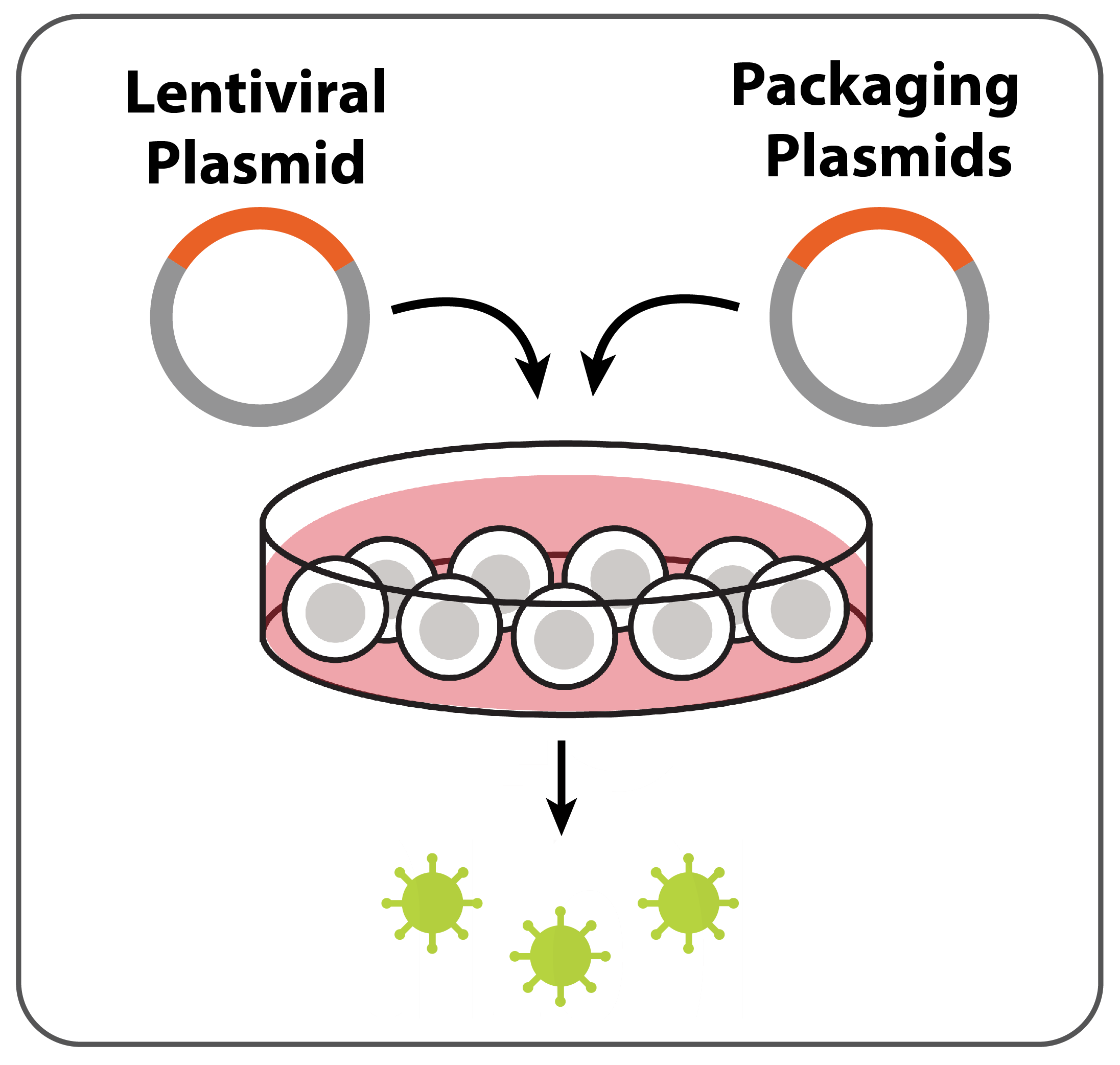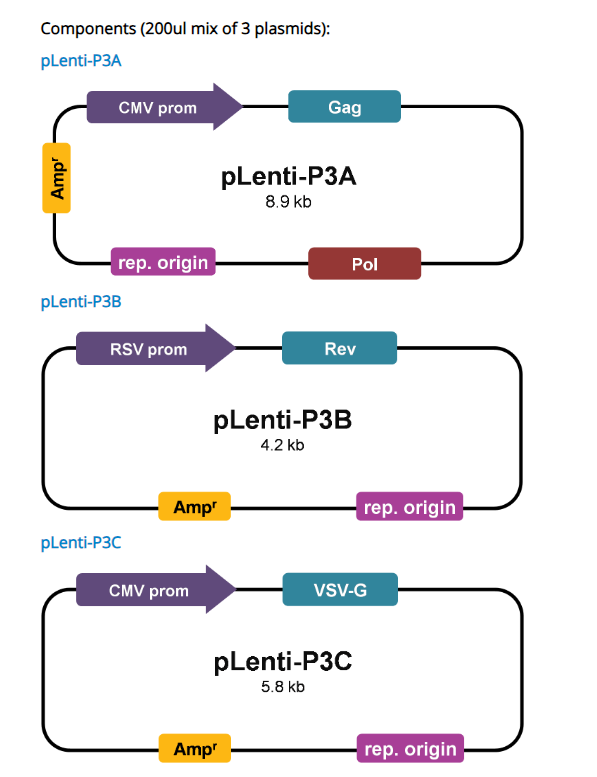3rd Generation Packaging System Mix

|
Cat. No.
|
LV053 |
|---|---|
| Unit |
200µl
|
| Cat. No. | LV053 |
| Name | 3rd Generation Packaging System Mix |
| Unit | 200µl |
| Description | For the production of lentiviral particles, three components are generally required: 1) a lentiviral vector containing your inserts of interest, 2) one or two packaging vectors which contain all necessary viral structure proteins, 3) an envelope vector expressing Vesicular Stomatitis Virus (VSV) glycoprotein (G).
The 3rd generation packaging system offers maximal biosafety as the lentiviral Rev gene is supplied as an independent vector from other structure genes, further eliminating the possibility of reverse recombination of vectors into replication competent viral particles. The 3rd generation lentiviral packaging mix will only support lentiviral expression vectors with a chimeric 5' LTR in which the HIV promoter is replaced with CMV or RSV, thus making it TAT-independent. The 3rd generation lentiviral vectors will not support the production of 2nd generation lentiviral particle productions. All of the lentiviral vectors marketed by ABM are TAT-independent.
*User Manual Refer to website for downloadable user manual |
| Note | NOT FOR RESALE without prior written consent of ABM. This product is distributed for laboratory research only. |
Print & Download Datasheet
What are the correct concentration units for each recombinant viral particle?
What do I use to check if my cells were successfully immortalized by the SV40 agent?
We have an SV40 T antibody that can be used for the western blot analysis. The catalog number is G202. Otherwise, a qPCR primer can be designed on the SV40 gene for qPCR analysis. The sequence can be found in the link below: http://www.abmgood.com/pLenti%20SV40-Vector-Location-Map.html
What are the primers to use for SV40 identification?
SV40 Forward Primer Sequence 5’ ACTGAGGGGCCTGAAATGA SV40 Reverse Primer Sequence 5’ GACTCAGGGCATGAAACAGG These are qPCR primers and the band size is 61 bp.
How do I convert a generation 3 lentiviral vector into a vector that can be used by generation 2 packaging system?
All second generation packaging systems can package both second and third generation lentiviral expression vectors.
Is it possible to make our own plasmid preparations from the packaging mix and then use them in transfections?
Unfortunately it is not possible to amplify these plasmids as they are provided in a pre-made mixture.
What advantages / disadvantages exist between the Lenti-SV40, -SV40T, and SV40T+t vectors?
There are simply differences in the content of all vectors due to customer demand for variety. Lenti-SV40 will contain the whole SV40 gene, -SV40T, the large T Antigen only, and -SV40T&t the large and small T antigens only. It is up to the end user to decide which vectors will best suit their project, however we have successfully used Lenti-SV40 (whole gene) in a wide range of immortalization projects.
Can I use 2nd Generation Packaging System for generation of lentivirus for pLKO.1 ShRNA knockdown vectors?
If you are using lentiviral vectors that are compatible with a second generation packaging system then it should be fine, however, we have not tested this in house.
Which system should I use to package my TAT dependent vector?
TAT dependent vectors will need to be packaged using a 2nd generation system (abm Cat LV003). 3rd generation packaging systems (abm Cat. LV053) will not be compatible with this type of vector.
What is the accession number for the SV40?
The SV40 covers the entire genome and the accession number is J02400.1. You can use this information to design primers for conventional PCR as well.
How long after transduction can the infection efficiency be observed?
You can observe transduction efficiency from 48 hours up to 5 days after infection.
What is the titer for viruses made by Cat# LV003 with 293T cells?
For both our 2nd or 3rd generation packaging mixes, the crude viral supernatant (i.e. not concentrated nor purified) titer will be around 10^6IU/ml.
What are the primers to use for SV40T and SV40T tsA58 detection?
PCR primers: SV40T Forward Primer Sequence 5’ AGCCTGTAGAACCAAACATT 3' SV40T Reverse Primer Sequence 5’ CTGCTGACTCTCAACATTCT 3' The two primers should amplify the region between 3677-4468bp, giving a 792bp fragment.
What is the sequence of the SV40 large T antigen?
This information can be accessed on this page by clicking on "pLenti-SV40-T" under vector map. The Large T antigen is at position 5079-5927.
For G221 and LV620, what does the 'V12' in RasV12 mean?
The V12 means that amino acid # 12 is mutated from a Valine to a Glycine. Other than that, the sequence matches the coding region of HRAS perfectly (NM_005343).
Where is the SV40T tsA58 gene sequence?
The SV40T tsA58 gene is located between 3138-5264bp, with the Alanine-to-Valine mutation at amino acid 438.
- Chan, MM et al. "Proteome profile and lentiviral transduction of cultured honey bee (Apis mellifera L.) cells" Insect Mol Biol 19(5):653-8 (2010). DOI: 10.1111/j.1365-2583.2010.01022.x. PubMed: 20546039.
- Ordelheide, AM et al. "Nor-1, a novel incretin-responsive regulator of insulin genes and insulin secretion" Mol Metab 2(3):243-55 (2013). DOI: 10.1016/j.molmet.2013.06.003. PubMed: 24044104.
- Kim, D et al. "Peroxisomal dysfunction is associated with up-regulation of apoptotic cell death via miR-223 induction in knee osteoarthritis patients with type 2 diabetes mellitus" Bone 64C:124-131 (2014). DOI: 10.1016/j.bone.2014.04.001. PubMed: 24727161.
- Kim, D et al. " Two non-coding RNAs, MicroRNA-101 and HOTTIP contribute cartilage integrity by epigenetic and homeotic regulation of integrin-α1" Cell. Signal. 25:2878 - 87 (2013). DOI: 10.1016/j.cellsig.2013.08.034. PubMed: 24018042. Application: Viral Packaging.
- George, R et al. "A SHORT INTERFERING RNA MOLECULAR BEACON FOR THE ATTENUATION OF MYCOBACTERIAL INFECTION" American Journal of Biochemistry and Biotechnology 10:40-49 (2014). DOI: 10.3844/ajbbsp.2014.40.49. Application: Viral Packaging.
- Song, J et al. "A long non-coding RNA, GAS5, plays a critical role in the regulation of miR-21 during osteoarthritis" Journal of Orthopaedic Research 32(12):1628-1635 (2014). DOI: 10.1002/jor.22718. PubMed: 25196583.
- Song, J et al. "MicroRNA-222 regulates MMP-13 via targeting HDAC-4 during osteoarthritis pathogenesis" BBA Clin : (2014). DOI: 10.1016/j.bbacli.2014.11.009. PubMed: 26673737.
- Morgan, S et al. "β-Agonist-mediated relaxation of airway smooth muscle is protein kinase A-dependent" J Biol Chem 289(33):23065-23075 (2014). DOI: 10.1074/jbc.M114.557652. PubMed: 24973219.
- Kim, D et al. "Peroxisomal dysfunction is associated with up-regulation of apoptotic cell death via miR-223 induction in knee osteoarthritis patients with type 2 diabetes mellitus" Bone 64:124-131 (2014). DOI: 10.1016/j.bone.2014.04.001. PubMed: 24727161. Application: Viral Packaging.
- Song, J et al. "miR-370 and miR-373 regulate the pathogenesis of osteoarthritis by modulating one-carbon metabolism via SHMT-2 and MECP-2, respectively" Aging Cell 5:826-837 (2015). DOI: 10.1111/acel.12363. PubMed: 26103880.
- Song, J et al. "A long non-coding RNA, GAS5, plays a critical role in the regulation of miR-21 during osteoarthritis" J Orthop Res 32(12):1628-1635 (2014). DOI: 10.1002/jor.22718. PubMed: 25196583. Application: Gene Delivery, Lentivirus.
- Song, J et al. "MicroRNA-222 regulates MMP-13 via targeting HDAC-4 during osteoarthritis pathogenesis" BBA Clin. :79-89 (2015). DOI: 10.1016/j.bbacli.2014.11.009.
- Song, J et al. "PBMC and exosome-derived Hotair is a critical regulator and potent marker for rheumatoid arthritis" Clin Exp Med. 1:121-126 (2015). DOI: 10.1007/s10238-013-0271-4. PubMed: 24722995.
- Kang, Y et al. "PCGEM1 stimulates proliferation of osteoarthritic synoviocytes by acting as a sponge for miR-770" J Orthop Res. : (2015). DOI: 10.1002/jor.23046.
- Rong, H et al. ""Notch signaling suppresses regulatory T cell function in murine experimental autoimmune uveitis "" Immunology 149.4:447-459 (2016). DOI: 10.1111/imm.12663.
- Wang, J et al. "Radiofrequency hyperthermia-enhanced herpes simplex virus-thymidine kinase/ganciclovir direct intratumoral gene therapy of hepatocellular carcinoma" American Journal of Cancer Research 6.9:2054–2063 (2016). DOI: 10.1080/02656736.2016.1229045. Application: Animal infection.
- Kang, et al. "PCGEM1 stimulates proliferation of osteoarthritic synoviocytes by acting as a sponge for miR-770" Journal of Orthopaedic Research 34.3:412 (2016). DOI: 10.1002/jor.23046. Application: Lentiviral infection.
- Jin, G., Li, Y., Zhang, F., Li, P., Zhao, L., Zhou, Y., ... & Yang, X. "Epithelial ovarian cancer: feasibility of image-guided intratumoral radiofrequency hyperthermia-enhanced direct gene therapy" American journal of cancer research 9(2):378 (2019).
- Omura, H., Liu, F., Shimakami, T., Murai, K., Shirasaki, T., Kitabayashi, J., Funaki, M., Nishikawa, T., Nakai, R., Sumiyadorj, A., Hayashi, T., Yamashita, T., Honda, M., Kaneko, S. "Establishment and Characterization of a New Cell Line Permissive for Hepatitis C Virus Infection" Scientific Reports 9:7943 (2019). DOI: 10.1038/s41598-019-44257-5.
This product has no review yet.
Controls and Related Product:



